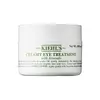What's inside
What's inside
 Key Ingredients
Key Ingredients

 Benefits
Benefits

 Concerns
Concerns

 Ingredients Side-by-side
Ingredients Side-by-side

Water
Skin ConditioningCetyl Alcohol
EmollientCetearyl Alcohol
EmollientGlycerin
HumectantOlea Europaea Fruit Oil
MaskingHelianthus Annuus Seed Oil
EmollientCocos Nucifera Oil
MaskingCI 77947
Alcohol Denat.
AntimicrobialKaolin
AbrasiveCoco-Glucoside
CleansingGossypium Herbaceum Flower Extract
HumectantOryza Sativa Extract
AbsorbentBeta Vulgaris Root Extract
Skin ConditioningArtemisia Umbelliformis Extract
Skin ConditioningEuphrasia Officinalis Extract
AntimicrobialButyrospermum Parkii Butter
Skin ConditioningSaccharum Officinarum Extract
MoisturisingAloe Barbadensis Leaf Juice
Skin ConditioningCarrageenan
Ricinus Communis Seed Oil
MaskingSucrose
HumectantFructose
HumectantGlucose
HumectantInositol
HumectantCitric Acid
BufferingBenzoic Acid
MaskingLactic Acid
BufferingTrehalose
HumectantXanthan Gum
EmulsifyingPotassium Sorbate
PreservativeSodium Benzoate
MaskingSodium PCA
HumectantPhenoxyethanol
PreservativeWater, Cetyl Alcohol, Cetearyl Alcohol, Glycerin, Olea Europaea Fruit Oil, Helianthus Annuus Seed Oil, Cocos Nucifera Oil, CI 77947, Alcohol Denat., Kaolin, Coco-Glucoside, Gossypium Herbaceum Flower Extract, Oryza Sativa Extract, Beta Vulgaris Root Extract, Artemisia Umbelliformis Extract, Euphrasia Officinalis Extract, Butyrospermum Parkii Butter, Saccharum Officinarum Extract, Aloe Barbadensis Leaf Juice, Carrageenan, Ricinus Communis Seed Oil, Sucrose, Fructose, Glucose, Inositol, Citric Acid, Benzoic Acid, Lactic Acid, Trehalose, Xanthan Gum, Potassium Sorbate, Sodium Benzoate, Sodium PCA, Phenoxyethanol
Water
Skin ConditioningButyrospermum Parkii Butter
Skin ConditioningButylene Glycol
HumectantTridecyl Stearate
EmollientPEG-30 Dipolyhydroxystearate
EmulsifyingIsodecyl Salicylate
Skin ConditioningTridecyl Trimellitate
EmollientPersea Gratissima Oil
Skin ConditioningIsocetyl Stearoyl Stearate
EmollientPropylene Glycol
HumectantDipentaerythrityl Hexacaprylate/Hexacaprate
EmulsifyingSorbitan Sesquioleate
EmulsifyingMagnesium Sulfate
Hydrogenated Castor Oil
EmollientSodium PCA
HumectantPhenoxyethanol
PreservativeChlorphenesin
AntimicrobialHydrogenated Jojoba Oil
AbrasiveP-Anisic Acid
MaskingTocopheryl Acetate
AntioxidantIsopropyl Palmitate
EmollientDisodium EDTA
Copper PCA
HumectantHelianthus Annuus Seed Oil
EmollientCI 40800
Cosmetic ColorantCitric Acid
BufferingWater, Butyrospermum Parkii Butter, Butylene Glycol, Tridecyl Stearate, PEG-30 Dipolyhydroxystearate, Isodecyl Salicylate, Tridecyl Trimellitate, Persea Gratissima Oil, Isocetyl Stearoyl Stearate, Propylene Glycol, Dipentaerythrityl Hexacaprylate/Hexacaprate, Sorbitan Sesquioleate, Magnesium Sulfate, Hydrogenated Castor Oil, Sodium PCA, Phenoxyethanol, Chlorphenesin, Hydrogenated Jojoba Oil, P-Anisic Acid, Tocopheryl Acetate, Isopropyl Palmitate, Disodium EDTA, Copper PCA, Helianthus Annuus Seed Oil, CI 40800, Citric Acid
 Reviews
Reviews

Ingredients Explained
These ingredients are found in both products.
Ingredients higher up in an ingredient list are typically present in a larger amount.
This ingredient is also known as shea butter. It is an effective skin hydrator and emollient.
Emollients help soothe and soften your skin. It does this by creating a protective film on your skin. This barrier helps trap moisture and keeps your skin hydrated. Emollients may be effective at treating dry or itchy skin.
Shea butter is rich in antioxidants. Antioxidants help fight free-radicals, or molecules that may harm the body. It is also full of fatty acids including stearic acid and linoleic acid. These acids help replenish the skin and keep skin moisturized.
While Shea Butter has an SPF rating of about 3-4, it is not a sunscreen replacement.
Shea butter may not be fungal acne safe. We recommend speaking with a professional if you have any concerns.
Learn more about Butyrospermum Parkii ButterCitric Acid is an alpha hydroxy acid (AHA) naturally found in citrus fruits like oranges, lemons, and limes.
Like other AHAs, citric acid can exfoliate skin by breaking down the bonds that hold dead skin cells together. This helps reveal smoother and brighter skin underneath.
However, this exfoliating effect only happens at high concentrations (20%) which can be hard to find in cosmetic products.
Due to this, citric acid is usually included in small amounts as a pH adjuster. This helps keep products slightly more acidic and compatible with skin's natural pH.
In skincare formulas, citric acid can:
While it can provide some skin benefits, research shows lactic acid and glycolic acid are generally more effective and less irritating exfoliants.
Most citric acid used in skincare today is made by fermenting sugars (usually from molasses). This synthetic version is identical to the natural citrus form but easier to stabilize and use in formulations.
Read more about some other popular AHA's here:
Learn more about Citric AcidHelianthus Annuus Seed Oil is the oil derived from the seeds of a Sunflower. Sunflower seed oil is non-fragrant. It is an emollient, meaning it helps to soften the skin.
Sunflower seed oil contains many fatty acids. The fatty acids found in sunflower seeds include (from highest amount to least): linoleic acid, myristic acid, palmitic acid, stearic acid, arachidic acid, oleic acid, and linolenic acid.
These fatty acids help the skin create ceramides. Ceramides play a role in repairing the skin barrier.
Helianthus Annuus Seed Oil helps moisturize the skin. This in turn helps the skin look more rejuvenated and smoother.
Sunflowers are rich in vitamin E.
Historians believe Indigenous cultures of North America domesticated sunflowers before corn. Thus they relied on sunflower oil for a variety of uses. One such use is moisturizing skin and hair.
Sunflower seed oil may not be fungal acne safe. We recommend speaking with a professional if you have any concerns.
Learn more about Helianthus Annuus Seed OilPhenoxyethanol is a preservative that has germicide, antimicrobial, and aromatic properties. Studies show that phenoxyethanol can prevent microbial growth. By itself, it has a scent that is similar to that of a rose.
It's often used in formulations along with Caprylyl Glycol to preserve the shelf life of products.
Sodium PCA is the sodium salt of pyroglutamic acid. It is naturally occurring in our skin's natural moisturizing factors where it works to maintain hydration.
The PCA stands for pyrrolidone carboxylic acid, a natural amino acid derivative.
This ingredient has skin conditioning, anti-inflammatory, and humectant properties. Humectants help hydrate your skin by drawing moisture from the air. This helps keep your skin moisturized.
Learn more about Sodium PCAWater. It's the most common cosmetic ingredient of all. You'll usually see it at the top of ingredient lists, meaning that it makes up the largest part of the product.
So why is it so popular? Water most often acts as a solvent - this means that it helps dissolve other ingredients into the formulation.
You'll also recognize water as that liquid we all need to stay alive. If you see this, drink a glass of water. Stay hydrated!
Learn more about Water